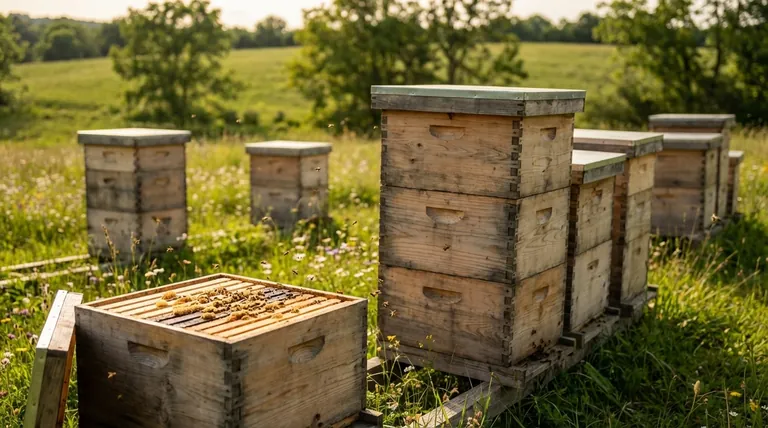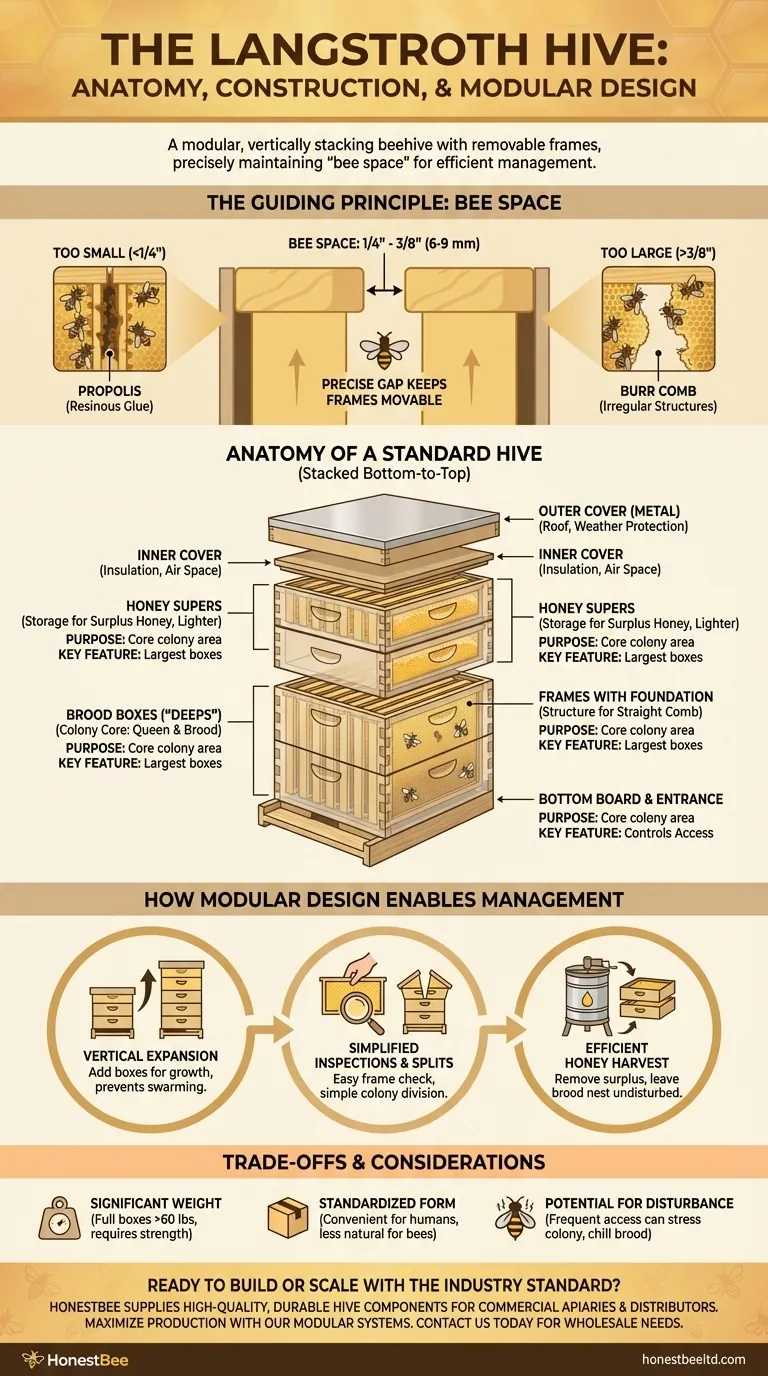At its core, the Langstroth hive is a modular, vertically stacking beehive designed around the principle of removable frames. It consists of a series of standardized boxes, each holding either eight or ten frames, which are stacked on top of one another to accommodate a growing colony and store honey.
The revolutionary concept behind the Langstroth hive is its precise maintenance of "bee space." This specific gap around each frame prevents bees from sealing the hive components together, allowing beekeepers to easily remove and inspect individual frames without destroying the colony's structure.

The Guiding Principle: Understanding "Bee Space"
The entire functionality of a Langstroth hive hinges on a single, critical measurement known as bee space. This refers to a gap of 1/4 to 3/8 of an inch (6-9 mm).
Why Spacing is Everything
Bees will instinctively fill any gap smaller than 1/4 inch with propolis, a resinous glue. They will fill any space larger than 3/8 inch with burr comb.
The Langstroth design maintains this exact bee space around all sides of each frame. This simple but brilliant insight is what makes the frames movable, forming the foundation of modern beekeeping.
Anatomy of a Standard Langstroth Hive
A hive is assembled by stacking several key components. While configurations vary, a typical setup includes the following parts, from bottom to top.
The Foundation: Bottom Board and Entrance
The hive rests on a bottom board, which forms the floor of the structure. This component includes an entrance, often fitted with a reducer to control access for the bees, especially for smaller or newer colonies.
The Colony's Core: Brood Boxes
The first and largest boxes stacked on the bottom board are the brood boxes or "deeps." This is the heart of the colony, where the queen lays eggs and the bees raise new brood (larvae). A colony may have one or two brood boxes.
The Pantry: Honey Supers
Above the brood boxes, beekeepers add shallower boxes called honey supers. These are intended specifically for the bees to store surplus honey. Their smaller size makes them lighter and easier to lift when full of honey.
The Internal Structure: Frames and Foundation
Each box contains either eight or ten removable frames. These wooden or plastic rectangles hold a sheet of foundation—typically wax or plastic imprinted with a honeycomb pattern—which encourages the bees to build straight, orderly comb.
The Roof: Inner and Outer Covers
An inner cover sits on top of the uppermost box, providing a dead air space for insulation and an additional entrance. Finally, a telescoping outer cover, often clad in metal, acts as the hive's roof, protecting it from the elements.
How the Modular Design Enables Management
The Langstroth's standardized, modular design is what makes it so popular among both hobbyist and commercial beekeepers. It provides unparalleled flexibility.
Vertical Expansion
As a colony's population and honey stores grow, the beekeeper can simply add more boxes (supers) to the top of the stack. This provides nearly limitless space and prevents the colony from swarming due to overcrowding.
Simplified Inspections and Splits
The movable frames allow a beekeeper to inspect the health of the queen, check for diseases, and monitor food stores on a frame-by-frame basis. This modularity also makes it easy to split a strong hive into two by simply dividing the boxes and resources.
Efficient Honey Harvest
Harvesting is straightforward. The beekeeper removes the honey supers, which are separate from the brood nest, ensuring the colony's core is left undisturbed with enough food to survive.
Understanding the Trade-offs
While it is the industry standard, the Langstroth design is not without its challenges.
Significant Weight
A deep brood box or a full honey super can weigh over 60 pounds (27 kg). Managing a tall stack of these boxes requires significant physical strength and lifting.
Standardization Over Natural Form
The hive's rectangular boxes and uniform frames force bees to build in a way that is convenient for humans, but less like the cavities they would choose in nature.
Potential for Disturbance
The very ease of inspection can be a downside. Opening the hive too frequently can stress the colony, disrupt their work, and chill the sensitive brood nest.
Is the Langstroth Hive Right for You?
Choosing a hive design depends entirely on your beekeeping goals. The Langstroth excels in specific areas due to its unique construction.
- If your primary focus is honey production and operational efficiency: The Langstroth's standardized components, ease of expansion, and compatibility with mechanized extraction equipment make it the unrivaled choice.
- If your primary focus is learning and straightforward colony management: The ability to easily inspect individual frames provides an invaluable window into the life of the hive, making it ideal for new beekeepers.
- If you have physical limitations or prioritize minimal lifting: The weight of full boxes is a serious consideration, and you may want to explore alternative designs like Top Bar or Warre hives.
Ultimately, the Langstroth hive's enduring success comes from its brilliant solution to the core challenge of beekeeping: accessing the colony's work without destroying it.
Summary Table:
| Component | Purpose | Key Feature |
|---|---|---|
| Bottom Board | Hive foundation and entrance | Controls bee access, often with a reducer |
| Brood Boxes | Core colony area for queen and brood | Largest boxes, heart of the hive |
| Honey Supers | Storage for surplus honey | Shallower boxes, easier to lift when full |
| Frames & Foundation | Structure for comb building | Removable, encourages straight comb |
| Inner/Outer Covers | Insulation and weather protection | Provides dead air space and roof |
Ready to build or scale your apiary with the industry-standard Langstroth hive?
At HONESTBEE, we supply high-quality, durable beekeeping supplies and equipment directly to commercial apiaries and beekeeping equipment distributors through our wholesale-focused operations. Our Langstroth hive components are built to last, ensuring efficient colony management and maximum honey production.
Let us help you succeed:
- For Commercial Apiaries: Boost your operational efficiency with our standardized, modular hive systems.
- For Distributors: Stock reliable, high-demand equipment that beekeepers trust.
Contact HONESTBEE today to discuss your wholesale needs and get a quote!
Visual Guide

Related Products
- Langstroth Bee Hives Bee Keeping Box for Beginners Beekeeping
- HONESTBEE Professional Multi-Functional Hive Tool with Ergonomic Wood Handle
- Long Langstroth Style Horizontal Top Bar Hive for Wholesale
- HONESTBEE Advanced Ergonomic Stainless Steel Hive Tool for Beekeeping
- HONESTBEE Professional Long Handled Hive Tool with Precision Cutting Blade
People Also Ask
- What are the different types of beehive boxes available? Choose the Right Hive for Your Apiary
- What basic equipment is needed to start beekeeping? Your Essential Guide to a Confident Start
- Why might a beginner be advised to start with a Langstroth hive? Unlock a Supportive Beekeeping Ecosystem
- Why were wooden hives traditionally preferred? For Natural Beekeeping Aligned with Bee Biology
- What are the key features of the Langstroth beehive? A Guide to the Standard for Modern Beekeeping



















